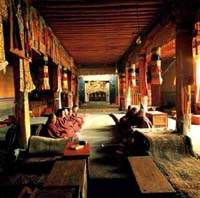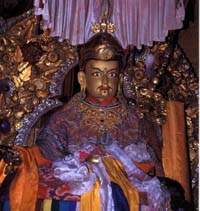
Padmasambhava was born in Pakistan during the eighth century. He was a great master of the ancient Indian Esoteric Sect and founder of the Rnyingma Sect. He was also the brother-in-law to Santaraksita, a famous great master of Buddhism.
During the rule of the Tubo king Khrisrong Indeltsan, the great master Santaraksita was invited to preach Buddhism in Tibet. But he was opposed by the ministers believing in the Bon Sect and had to leave the kingdom. Before he departed, however, he suggested that the king invite Padmasaminate the religion in Tibet.
The king adopted this suggestion and sent one of his ministers to India with the invitation. Part way there, the minister met Padmasambhava and together the two traveled to Tibet. The king was happy about the arrival of the great master Padmasambhava and received him at the palace.
In 722, Padmasambhava with the support of the king prepared to build the Bsamyas Monastery, the earliest one for lama tonsuring in the history of the Tubo Kingdom. After surveying the land several times, Padmasambhava selected a construction site in today's Zhanang County of Shannan Prefecture on the northern bank of the Yarlung Zangbu River. During the construction, the relations within the3 sect gradually became quite tense because of opposition from the Bon religion. The Buddhist beliefs and practices gradually changed until the religion was accepted by ordinary people of the kingdom because of the master's great knowledge of Buddhism and the intercommunications between Esoteric Buddhism and the Bon religion. Bsamyas Monastery was thus built.
It was built according to the understanding of Padmasambhava and other persons and absorbed the architectural styles of India, Tubo and the areas where Han people lived. It also became known as the first monastery in the region that possessed lamas, statues of Buddha, Buddhist texts and pagodas. In 779, Khristrong Idebtsan presided the unveiling ceremony for the Bsamyas Monastery when it was completed.

Padmasambhava spared no pains in preaching the religion and put forward concrete measures for conquering nature and improving production. Starting with him, the Esoterics of the Greating Vehicle spread into the entire region and gradually formed a complete system of Tibetan Esoterics. The great master did every kind of abhiseka for the king. The king rewarded him by sending one of his own concubines to him. However, due to censure by the ministers of the Bon Sect, Padmasambhava had to leave the place soon after the construction of the monastery. He remained there for a total of 18 months.
His preaching of buddhism and the magic invocations of the Esoterics of the Greater Vehicle greatly influenced the Rnyingma Sect in Tibet. Because of this, he is called as the founded of the sect. Today, legends tell about him to subdue evil spirits. A story says that he waved a gold stick to change cold lake water into very hot water so as to subdue an evil goddess. Another says that he burned a mountain into a pile of charcola in order to chase out 12 demons of the Bon sect. Those deities of that sect after-ward became protectors of the Buddhist doctrines.
Santaraksita appraised him highly and believed that because of his subduing of the 12 protectors of the doctrine of the Bon Sect, the Tubo Kingdom was able to develop peacefully.
Tibetan Buddhism preserves some popular writings, including the "Five Volumes of Biography," said to have been written by Padmasambhava.
